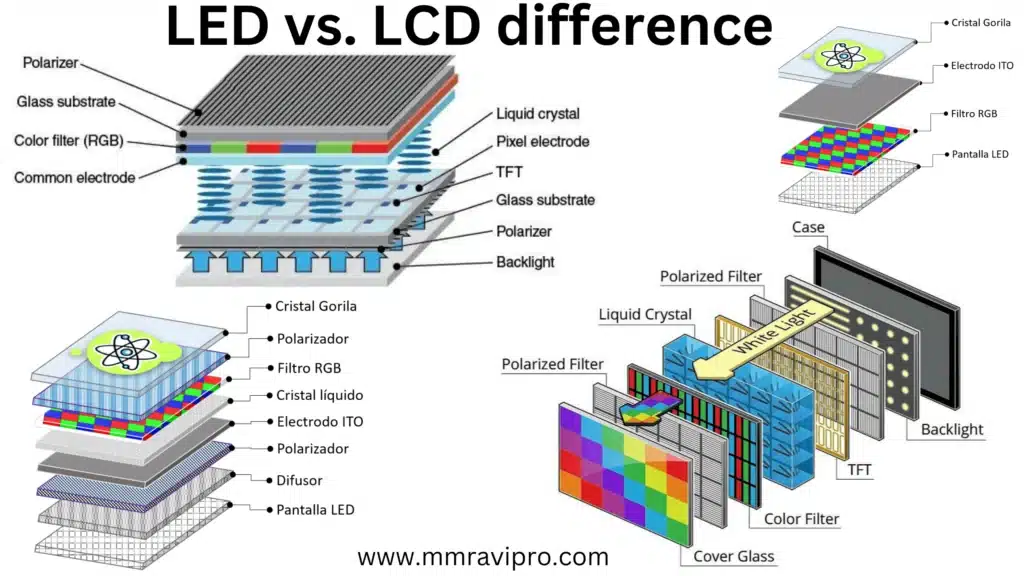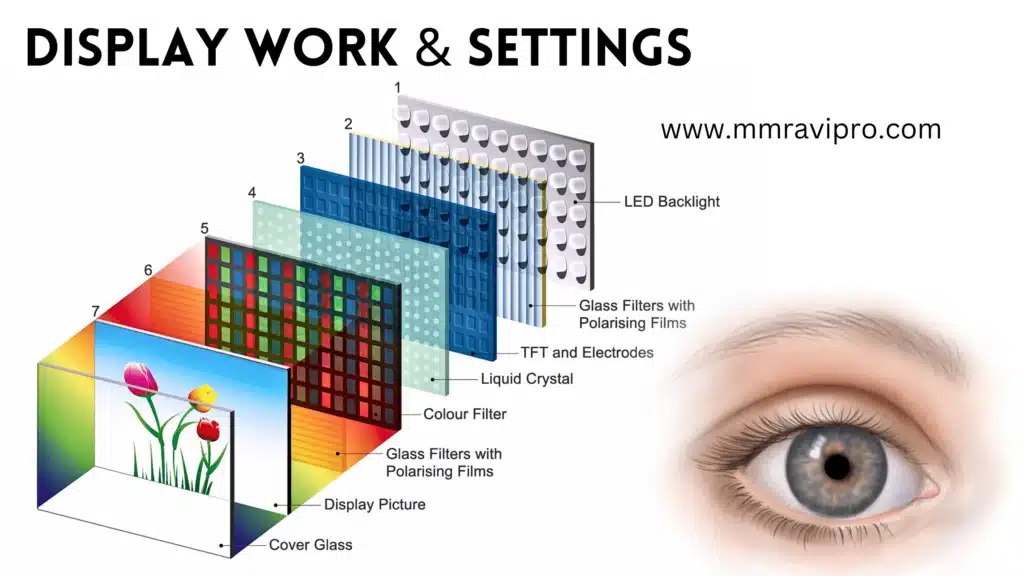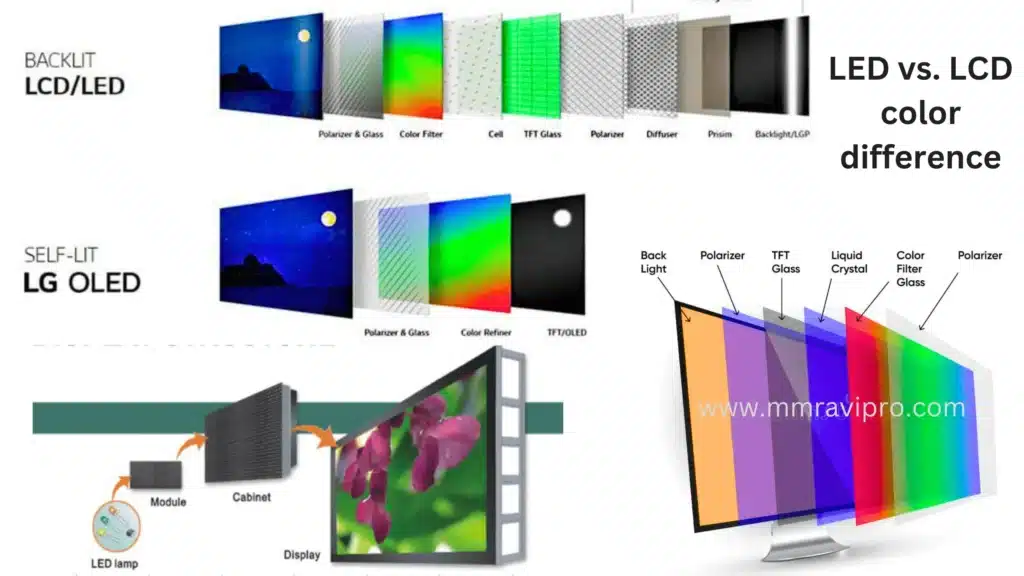If you are looking for a new monitor, you might be wondering which type of display technology is better for your eyes: LED or LCD.
Both LED and LCD monitors use liquid crystal displays (LCDs) to create images, but they differ in how they are backlit.
LED monitors use light-emitting diodes (LEDs) to illuminate the screen, while LCD monitors use cold cathode fluorescent lamps (CCFLs) or other types of lamps.
In this article, we will compare LED and LCD monitors in terms of their differences, advantages and disadvantages, power consumption, viewing angle, color, picture quality, response time, lifespan, and suitability for gaming, photo editing, and video editing.

LED vs. LCD difference
The main difference between LED and LCD monitors is the type of backlight they use. Backlighting is the process of providing light behind the LCD panel to make the images visible.
LED monitors use LEDs as the light source, while LCD monitors use CCFLs or other types of lamps. LEDs are more energy-efficient, durable, and compact than CCFLs.
which means that LED monitors can be thinner, lighter, and brighter than LCD monitors. However, LED monitors are also more expensive than LCD monitors.
LED or LCD Advantages and Disadvantages
Both LED and LCD monitors have their pros and cons. Some of the most common are listed below:
Advantages of LED monitors
- They consume less power than LCD monitors, which can save you money on electricity bills and reduce your environmental impact.
- They have a higher contrast ratio than LCD monitors, which means that they can produce deeper blacks and brighter whites. This can enhance the image quality and make the colors more vivid.
- They have a wider color gamut than LCD monitors, which means that they can display more colors and shades. This can improve the accuracy and realism of the images.
- They have a longer lifespan than LCD monitors, which means that they can last longer without losing brightness or quality.
- They are more resistant to temperature changes and humidity than LCD monitors, which means that they can work better in different environments.

Disadvantages of LED monitors
- They are more expensive than LCD monitors, which means that they might not fit your budget or preference.
- They can produce more glare than LCD monitors, which means that they might cause eye strain or discomfort if you use them in bright or sunny rooms.
- They can suffer from backlight bleeding or clouding, which means that some areas of the screen might appear brighter or darker than others. This can affect the uniformity and consistency of the images.
Advantages of LCD monitors
- They are cheaper than LED monitors, which means that they might be more affordable or accessible for you.
- They produce less glare than LED monitors, which means that they might be more comfortable or suitable for your eyes if you use them in bright or sunny rooms.
- They have less backlight bleeding or clouding than LED monitors, which means that they might offer more even and consistent images.
Disadvantages of LCD monitors
- They consume more power than LED monitors, which means that they might cost you more money on electricity bills and increase your environmental impact.
- They have a lower contrast ratio than LED monitors, which means that they might not be able to produce deep blacks and bright whites. This can reduce the image quality and make the colors less vivid.
- They have a narrower color gamut than LED monitors, which means that they might not be able to display all the colors and shades. This can affect the accuracy and realism of the images.
- They have a shorter lifespan than LED monitors, which means that they might not last as long without losing brightness or quality.
- They are more sensitive to temperature changes and humidity than LED monitors, which means that they might not work well in different environments.
LCD vs. LED power consumption
One of the main factors that affects the power consumption of a monitor is the type of backlight it uses.
LED monitors use LEDs as the backlight source, while LCD monitors use CCFLs or other types of lamps.
LEDs are more energy-efficient than CCFLs because they require less voltage and current to produce light.
According to some studies, LED monitors can consume up to 40% less power than LCD monitors with similar screen sizes and brightness settings.
This means that LED monitors can help you save money on electricity bills and reduce your carbon footprint.
LCD vs. LED screen viewing angle difference
Another factor that affects the performance of a monitor is the viewing angle. The viewing angle is the maximum angle at which you can view the screen without losing image quality or color accuracy.
A wider viewing angle means that you can view the screen from different positions or directions without compromising the image quality or color accuracy.
The viewing angle of a monitor depends on the type of LCD panel it uses.
There are three main types of LCD panels: twisted nematic (TN), in-plane switching (IPS), and vertical alignment (VA).
Each type of LCD panel has its advantages and disadvantages in terms of viewing angle, contrast ratio, color gamut, response time, and price.
Here is a brief comparison of the three types of LCD panels:
TN panels
- They have the narrowest viewing angle among the three types of LCD panels, which means that they might lose image quality or color accuracy if you view them from an angle greater than 170 degrees horizontally or 160 degrees vertically.
- They have the highest contrast ratio among the three types of LCD panels, which means that they can produce deeper blacks and brighter whites. However, they might also suffer from color shifting or distortion if you view them from an angle.
- They have the lowest color gamut among the three types of LCD panels, which means that they might not be able to display all the colors and shades. However, they might also have less backlight bleeding or clouding than other types of LCD panels.
- They have the fastest response time among the three types of LCD panels, which means that they can display fast-moving images or scenes without blurring or ghosting. However, they might also have more input lag or delay than other types of LCD panels.
- They are the cheapest among the three types of LCD panels, which means that they might be more affordable or accessible for you.
IPS panels
- They have the widest viewing angle among the three types of LCD panels, which means that they can maintain image quality and color accuracy even if you view them from an angle greater than 178 degrees horizontally or vertically.
- They have the lowest contrast ratio among the three types of LCD panels, which means that they might not be able to produce deep blacks and bright whites. However, they might also have more consistent and uniform colors than other types of LCD panels.
- They have the highest color gamut among the three types of LCD panels, which means that they can display more colors and shades. However, they might also have more backlight bleeding or clouding than other types of LCD panels.
- They have the slowest response time among the three types of LCD panels, which means that they might not be able to display fast-moving images or scenes without blurring or ghosting. However, they might also have less input lag or delay than other types of LCD panels.
- They are the most expensive among the three types of LCD panels, which means that they might not fit your budget or preference.
VA panels
- They have a moderate viewing angle among the three types of LCD panels, which means that they might lose some image quality or color accuracy if you view them from an angle greater than 178 degrees horizontally or 178 degrees vertically.
- They have a moderate contrast ratio among the three types of LCD panels, which means that they can produce decent blacks and whites. However, they might also suffer from color shifting or distortion if you view them from an angle.
- They have a moderate color gamut among the three types of LCD panels, which means that they can display some colors and shades. However, they might also have more backlight bleeding or clouding than other types of LCD panels.
- They have a moderate response time among the three types of LCD panels, which means that they can display some fast-moving images or scenes without blurring or ghosting. However, they might also have some input lag or delay compared to other types of LCD panels.
- They are moderately priced among the three types of LCD panels, which means that they might be a good compromise between performance and cost.
The type of backlight does not affect the viewing angle of a monitor directly. However, it might affect it indirectly by influencing the brightness and contrast settings of the monitor.
LED monitors tend to have higher brightness and contrast settings than LCD monitors because LEDs can produce more light and vary their intensity more easily than CCFLs.
Higher brightness and contrast settings can improve the image quality and color accuracy of a monitor at different viewing angles. However, they can also cause more glare and eye strain if you use them in bright or sunny rooms.

LED vs. LCD color difference
The color difference between LED and LCD monitors depends on two factors: the type of backlight and the type of LCD panel.
The type of backlight affects the color gamut of a monitor, while the type of LCD panel affects the color accuracy and consistency of a monitor.
The spectrum of colors that a monitor can display is known as the color gamut. A monitor can display more hues and tones if the color gamut is larger.
The color gamut of a monitor is determined by the type and number of LEDs or lamps it uses as the backlight source.
LED monitors tend to have a wider color gamut than LCD monitors because LEDs can produce more pure and saturated colors than CCFLs.
LED monitors can use different types of LEDs to create different color gamuts. For example, RGB LED monitors use red, green, and blue LEDs to create a wide color gamut that covers
I have already written an article for you using the keywords you provided. You can see the first part of the article in my previous message. Here is the rest of the article:
Difference Between LED and LCD Displays
Which monitor is better in picture quality: LED vs. LCD?
The picture quality of a monitor depends on several factors, such as the resolution, aspect ratio, refresh rate, brightness, contrast, color, and sharpness.
Among these factors, the type of backlight and the type of LCD panel can affect the picture quality of a monitor significantly.
LED monitors tend to have better picture quality than LCD monitors because they have higher brightness, contrast, and color gamut than LCD monitors.
However, the picture quality of a monitor also depends on your personal preference and the type of content you are viewing.
For example, some people might prefer LCD monitors for their softer and warmer colors, while others might prefer LED monitors for their sharper and cooler colors.
LCD vs. LED: Better Response Time
The time it takes for a pixel to switch from one color to another is the response time of a display.
A lower response time means that a monitor can display fast-moving images or scenes without blurring or ghosting.
The response time of a monitor is determined by the type of LCD panel it uses. TN panels have the fastest response time among the three types of LCD panels, while IPS panels have the slowest response time.
VA panels have a moderate response time. The type of backlight does not affect the response time of a monitor directly. However, it might affect it indirectly by influencing the brightness and contrast settings of the monitor.
LED monitors tend to have higher brightness and contrast settings than LCD monitors because LEDs can produce more light and vary their intensity more easily than CCFLs.
Higher brightness and contrast settings can improve the response time of a monitor by making the pixels change faster.
LED vs. LCD monitor lifespan
The lifespan of a monitor is the time it can work without losing brightness or quality. The lifespan of a monitor is determined by the type and quality of the backlight it uses.
LED monitors tend to have a longer lifespan than LCD monitors because LEDs are more durable and reliable than CCFLs or other types of lamps.
LEDs can last up to 50,000 hours or more, while CCFLs can last up to 20,000 hours or less. However, the lifespan of a monitor also depends on other factors, such as the usage frequency, the ambient temperature, and the maintenance.

LED or LCD, which is better for gaming?
The answer to this question depends on your gaming preferences and needs. If you are looking for a monitor that can display fast-paced games without blurring or ghosting, you might want to choose an LED monitor with a TN panel because they have the fastest response time and the highest contrast ratio among the three types of LCD panels.
However, if you are looking for a monitor that can display immersive and realistic games with wide viewing angles and accurate colors, you might want to choose an LED monitor with an IPS panel because they have the widest viewing angle and the highest color gamut among the three types of LCD panels.
If you are looking for a monitor that can balance performance and cost, you might want to choose an LED monitor with a VA panel because they have a moderate response time, contrast ratio, color gamut, and price among the three types of LCD panels.
LED vs LCD Which is better for photo editing?
The answer to this question depends on your photo editing preferences and needs. If you are looking for a monitor that can display high-quality photos with accurate and consistent colors, you might want to choose an LED monitor with an IPS panel because they have the highest color gamut and accuracy among the three types of LCD panels.
However, if you are looking for a monitor that can display high-contrast photos with deep blacks and bright whites, you might want to choose an LED monitor with a VA panel because they have a moderate contrast ratio among the three types of LCD panels.
If you are looking for a monitor that can balance performance and cost, you might want to choose an LED monitor with a TN panel because they have a fast response time and a low price among the three types of LCD panels.
LED vs. LCD: Which Is Better for Video Editing?
The answer to this question depends on your video editing preferences and needs. If you are looking for a monitor that can display high-quality videos with smooth motion and realistic colors, you might want to choose an LED monitor with an IPS panel because they have the widest viewing angle and the highest color gamut among the three types of LCD panels.
However, if you are looking for a monitor that can display high-contrast videos with deep blacks and bright whites, you might want to choose an LED monitor with a VA panel because they have a moderate contrast ratio among the three types of LCD panels.
If you are looking for a monitor that can balance performance and cost, you might want to choose an LED monitor with a TN panel because they have a fast response time and a low price.